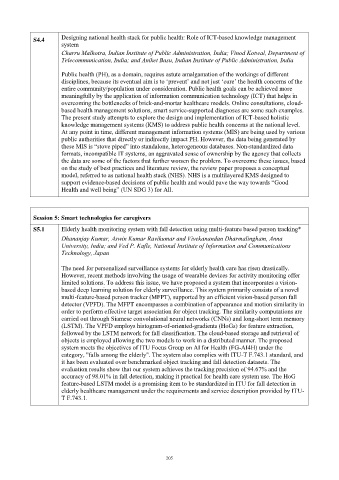Page 225 - ITU KALEIDOSCOPE, ATLANTA 2019
P. 225
S4.4 Designing national health stack for public health: Role of ICT-based knowledge management
system
Charru Malhotra, Indian Institute of Public Administration, India; Vinod Kotwal, Department of
Telecommunication, India; and Aniket Basu, Indian Institute of Public Administration, India
Public health (PH), as a domain, requires astute amalgamation of the workings of different
disciplines, because its eventual aim is to ‘prevent’ and not just ‘cure’ the health concerns of the
entire community/population under consideration. Public health goals can be achieved more
meaningfully by the application of information communication technology (ICT) that helps in
overcoming the bottlenecks of brick-and-mortar healthcare models. Online consultations, cloud-
based health management solutions, smart service-supported diagnoses are some such examples.
The present study attempts to explore the design and implementation of ICT-based holistic
knowledge management systems (KMS) to address public health concerns at the national level.
At any point in time, different management information systems (MIS) are being used by various
public authorities that directly or indirectly impact PH. However, the data being generated by
these MIS is “stove piped” into standalone, heterogeneous databases. Non-standardized data
formats, incompatible IT systems, an aggravated sense of ownership by the agency that collects
the data are some of the factors that further worsen the problem. To overcome these issues, based
on the study of best practices and literature review, the review paper proposes a conceptual
model, referred to as national health stack (NHS). NHS is a multilayered KMS designed to
support evidence-based decisions of public health and would pave the way towards “Good
Health and well being” (UN SDG 3) for All.
Session 5: Smart technologies for caregivers
S5.1 Elderly health monitoring system with fall detection using multi-feature based person tracking*
Dhananjay Kumar, Aswin Kumar Ravikumar and Vivekanandan Dharmalingham, Anna
University, India; and Ved P. Kafle, National Institute of Information and Communications
Technology, Japan
The need for personalized surveillance systems for elderly health care has risen drastically.
However, recent methods involving the usage of wearable devices for activity monitoring offer
limited solutions. To address this issue, we have proposed a system that incorporates a vision-
based deep learning solution for elderly surveillance. This system primarily consists of a novel
multi-feature-based person tracker (MFPT), supported by an efficient vision-based person fall
detector (VPFD). The MFPT encompasses a combination of appearance and motion similarity in
order to perform effective target association for object tracking. The similarity computations are
carried out through Siamese convolutional neural networks (CNNs) and long-short term memory
(LSTM). The VPFD employs histogram-of-oriented-gradients (HoGs) for feature extraction,
followed by the LSTM network for fall classification. The cloud-based storage and retrieval of
objects is employed allowing the two models to work in a distributed manner. The proposed
system meets the objectives of ITU Focus Group on AI for Health (FG-AI4H) under the
category, "falls among the elderly". The system also complies with ITU-T F.743.1 standard, and
it has been evaluated over benchmarked object tracking and fall detection datasets. The
evaluation results show that our system achieves the tracking precision of 94.67% and the
accuracy of 98.01% in fall detection, making it practical for health care system use. The HoG
feature-based LSTM model is a promising item to be standardized in ITU for fall detection in
elderly healthcare management under the requirements and service description provided by ITU-
T F.743.1.
– 205 –

